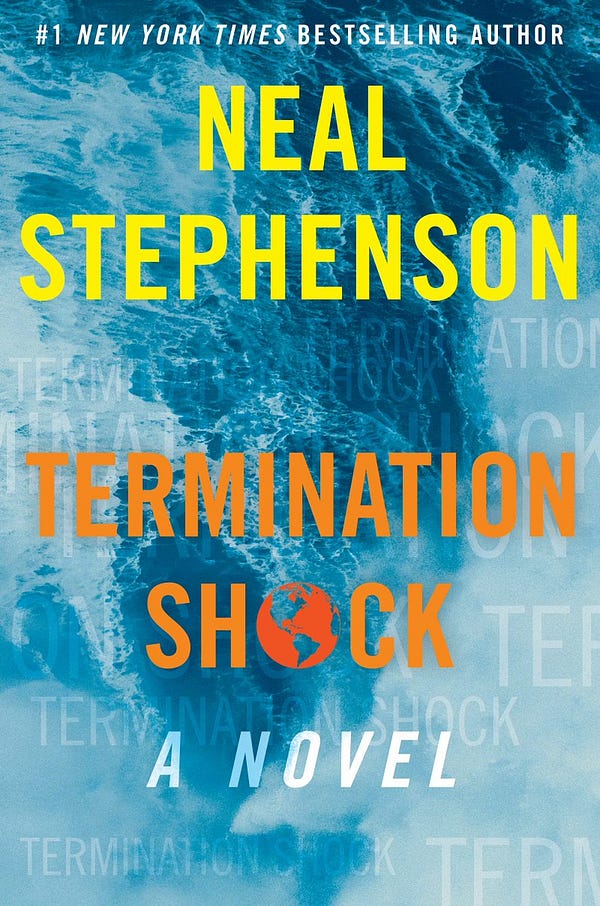Messaging aliens with the Financial Times
Capitalism's giant organ probes every limit to capital, with everything it's got. One day in the print life of the FT
The new neighbour at our new door asked me, among other practicalities, if I could pick up their delivered copy of the FT, while they were away. I digitally subscribe, I said, but it’ll be nice to relax with a real newspaper and a morning coffee. So they’ve been piling up prettily, in their impeccably biodegradable wrapping. It was time to open up one, at least. They were beginning to look like old parchments drawn up from a national archive.
Wrong. Maybe I was just lucky to unfold the Financial Times on Thursday, 6 January 2022. But these mere 22 pages were like holding some kind of shuddering portal to the near and far future, as well as the near and far past, directly in my hands. Again, as I’m so often finding when I write for this space: the complexity of the world is manifest, right before us. It waits for us to slow down enough to see it.
I should begin with what initially blew my mind, which were the three feature panels running under FINANCIAL TIMES, at the very height of what print journalists’ call the fold.
Perhaps more Black Mirror than Financial Times. A story about whether we should be trying to contact aliens; a story about drones which compares their military impact to “the tank or the airplane”; a story which details business attempts to direct the attention and intention of populations towards a virtual/augmented reality.
Let’s assume, strapping our Marxist goggles on, that the job of the Financial Times is not just to inform capitalists about the internal operations of capitalism, but also to alert them about the limits to capital. Meaning that which (and those who) might present a challenge to commoditisation, who might resist or constrain the endless penetrations and consumerisations of market forces. If we make that assumption, then the aliens story (one of their main op-ed pieces, by senior staff writer John Thornhill) is deeply intriguing.
Please note: it’s a lead feature item. So I wonder: are we now hearing about METI (messaging extra-terrestrial intelligence) because, somewhere deep in the rationality of the FT, they genuinely believe this might be a spoke in the accumulative wheels of capital? (Thornhill’s general beat is pretty cyber/astro/meta). Genuinely, imagine how irritating this would be for your uber tech-mogul. You see the solar system (and its asteroidal debris) as the next frontier for extraction, settlement and enclosure. Then you encounter some watching civilisation out there, wise and powerful enough to assert some limits on your expansion. Dammit!
The piece is sage enough in xenophilosophy to note that “aliens sophisticated enough to travel vast distances to reach earth… would be unlikely to need anything we have to offer”. So, reassures Thornhill, we should message away to the stars, assuming “humanity’s collective urge for discovery” is greater than “its fear of the unknown”. But captains of industry: at least the FT has alerted you!
Next, having scanned the cosmos for civilisational competitors, the paper turns its attention to more reliable business prospects—the military-industrial complex. Except the drones story is also about aerial technology (Thornhill’s story mentions the recently launched James Webb Space Telescope, whose function is to search for habitable exoplanets).
But this is aeriality under a different dynamic. Not giant, stately space observatories launched into space by intergovernmental efforts. But swarming, explosive-stuffed asymmetrical war machines, evading detection by the usual arrays of American/Western missile defense, which are comically overbearing for the task. They are called “Costco” drones, because they are as cheap as $1000, yet can bomb settlements or military camps, or get close to identified individuals.
ISIS and Iran are imaginative users of these Costcos; and the latest Western military thinking is that it takes a drone to disable a drone. So like something fished from the wastepaper bin of Jack Kirby, counter-drones are contending with their enemies in the sky—throwing nets over their whirring combatants, or spurting pink stringy spray, Spidey-like, to gum up their propellors. There’s more from Kirby’s trashcan: the companies have titles like D-Fend, Fortem (the Latin for “strong” and “brave”) and most cheesily, Anduril - the mightiest sword in all of Middle-Earth.
This feature is in the “Big Read” section of the paper—and it’s clearly a Big Opportunity for any military manufacturers reading it. A side bar calmly identifies the millions, hundreds of millions and scores of billions of investment and units involved in this theatre of war. And just to round off the prospectus, we end with a near-future of AI-powered swarms, speedily and autonomously adapting to circumstances - hiding in bushes, flying in bewildering formations.
(Some of you may remember Stuart Russell’s Reith Lectures, covered in E2 already. Russell’s talk on AI and its military uses references a piece of design fiction he consulted on in 2017, called Slaughterbots (embedded below). This film imagined tiny explosive drones who identified their victims by their unmistakable biosignature (DNA, facial recognition, pheromones). This is the same vector of infinite, exponential lethality as the Bond movie we explored last week. Seems like a consensus building, in the Thanatos Club...)
Any half-decent alien civilisation, viewing all this, might understandably respond: surely they’ll shred themselves to pieces, before we have to worry about their rapacity in interstellar space.
And if our observer’s one big eye hasn’t glazed over by now, then the FT’s diligent reporting on the construction of a collective digital hallucination will send it rolling upwards into its green socket. “Metaverse hardware boom predicted for 2022: sector aspirants expected to bet big on ‘picks and shovels’ that underpin technologies such as headsets, sensors and chips”, runs the informative headline.
So we may be bothering the universe with our messages, and finding every more precise ways to blow each other away - but don’t worry! In a biosphere where the most urgent ecological imperative is to reduce material throughput in the affluent zones of the world…we’re planning a hardware boom.
I made my bid, in a previous column, to imagine a metaverse which could also be a betaverse. That is, a simulatory tool whereby we could prototype, test and build agreement for the profound lifestyle changes that staying within planetary boundaries implies (while still answering our restless, radical natures).
There’s nothing like a FT business story to knock such “real utopianism” out of you. The picture illustrating the paper’s piece is that of a digital recreation of Manchester City’s Etihad stadium, by Sony, “for fans worldwide to visit virtually”. Four players surmount the simulated building, like the cliche-spouting, Cryuff-turning gods they are. “The metaverse lacks killer content, so people are not that interested in it yet”, says Lee Hyung-hak, chief executive of Warp Solution.
Perhaps killing content may be the killer content (vast simulated packhunts are surely more thrilling than a virtual score draw at Stamford Bridge)? And for the amounts of hydrocarbons and rare “conflict” minerals that will need to be extracted to make manifest Lee’s headset business, the externalities will be killer too.
Now, once again, don’t blame me for stringing these stories together. This was the FT’s editorial decision to lead with them. Together, they lay out a picture of a global industrial culture that is in a state (& stage) of technological frenzy - primarily excited by the off-planet, the in-battle and the search for transperience (my new word, explained here).
What’s interesting is to see how intrinsic climate and energy stories are to the news pages of this FT edition. But note the tone that dominates the stories: green business is tedious and troublesome all the way. Electric cars are mapping to a North-South inequality divide, because charging infrastructure accumulates around London. Wind farms are entangled in, and impeded by, NIMBYism. Carbon offsets, a problematic form of climate mitigation anyway, are increasing in price. A vegan-era company called Beyond Meat has become an “unappetising” prospect (boom boom).
Again, I concede: this is the FT on one, randomly opened day. To take a week (or month, or year) of the paper would represent a much fairer assessment of its overall stance. Who can deny it serves a world desperate for better insight and strategy? Perhaps because of my old and new media background, I am emotionally interested in those who try to bound and curate our relentless flow of information. I think it’s worth the effort.
There’s one last striking element in this FT of 6/1/22: the way that the arts coverage is both neatly cordoned-off, and civilizationally profound (the stays are loosened for the FT’s Weekend edition). For example, in this paper they profile the new show from the 76-year old German painter Anselm Kiefer. The works are based on Kiefer’s love of the poetry of Paul Celan, one of the most intense sensibilities to dwell on the Holocaust. Kiefer says: “Celan doesn’t use easy metaphors like Goethe, whose poetry is simpler to interpret…He doesn’t write, ‘My mother was killed in Auschwitz’, instead he says, ‘The hair of my mother never turned gray.’”
That’s a beautiful, terrible distinction—the kind of creativity that humans are capable of, even as we contemplate ourselves at our worst. I close the pages of this Thursday’s teeming, bristling Financial Times, and I wonder how we can bring better qualities of distinction to transformative technologies and institutions, whose powers are fully on display here. Either that, or we’re up in smoke, fragments and rags, as Kiefer’s art makes manifest.
LINKTOPIA
All the news that squints


🔮 The Well’s State of the World symposium this year has some veteran futurists taking shots at their top ten important items from 2021, and what will roll in 2022


🕸 The BBC and decentralised Web 3.0? Isn’t that oil and water? Not if you listen to the great and wise Bill Thompson, who wants the Beeb to be part of the next evolution of the internet, by means of supporting a “digital public sphere”, Habermas-style
🇸🇪 “Sweden has launched The Swedish Psychological Defence Agency - for identifying, analysing and responding to influence campaigns and 'misleading information' directed at Sweden or Swedish interests.” The SPDA does sound a little Ballardian…
🤖 Startling, multimedia article on the neuroscientist Peter Scott Morgan, who is almost entirely “locked in” to his body from a degenerative neurological disease, throwing. himself upon all available cyborg technologies.






Thanks for reading! Please comment below, and please share the newsletter with those who you think would like this content. Very best, PK



